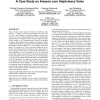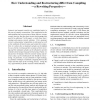26354 search results - page 92 / 5271 » How we refactor, and how we know it |
ICDE
2006
IEEE
14 years 11 months ago
2006
IEEE
Scheduling/prioritization of DBMS transactions is important for many applications that rely on database backends. A convenient way to achieve scheduling is to limit the number of ...
WWW
2009
ACM
14 years 10 months ago
2009
ACM
There are many on-line settings in which users publicly express opinions. A number of these offer mechanisms for other users to evaluate these opinions; a canonical example is Ama...
DSN
2005
IEEE
14 years 3 months ago
2005
IEEE
Fault-tolerant protocols, asynchronous and synchronous alike, make stationary fault assumptions: only a fraction f of the total n nodes may fail. Whilst a synchronous protocol is ...
IWPC
2003
IEEE
14 years 3 months ago
2003
IEEE
Syntactic and semantic analysis are established topics in the area of compiler construction. Their application to the understanding and restructuring of large software systems rev...
DT
1998
13 years 9 months ago
1998
The logic blocks of most modern FPGAs contain clusters of look-up tables and flip flops, yet little is known about good choices for several key architectural parameters related ...




